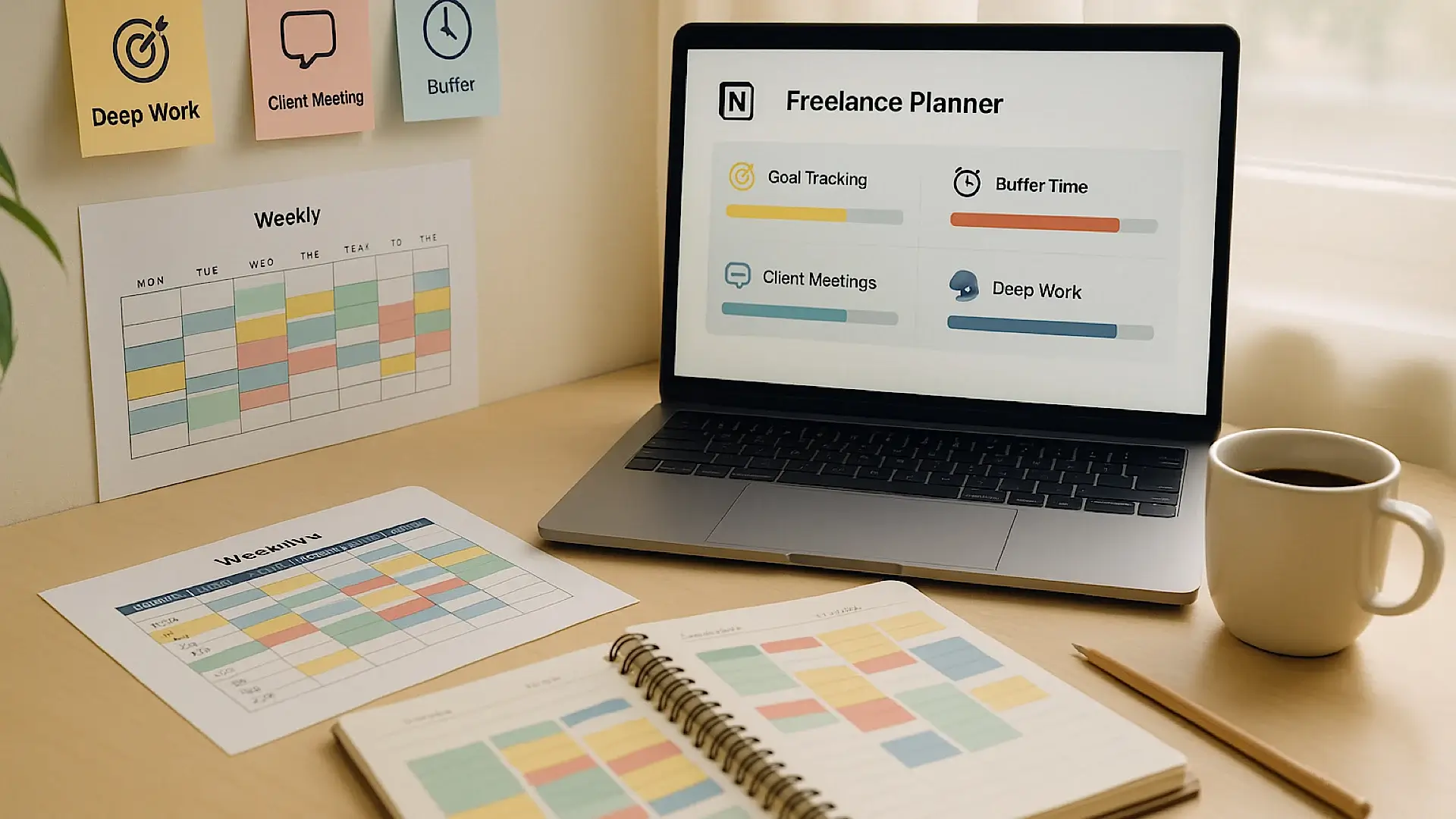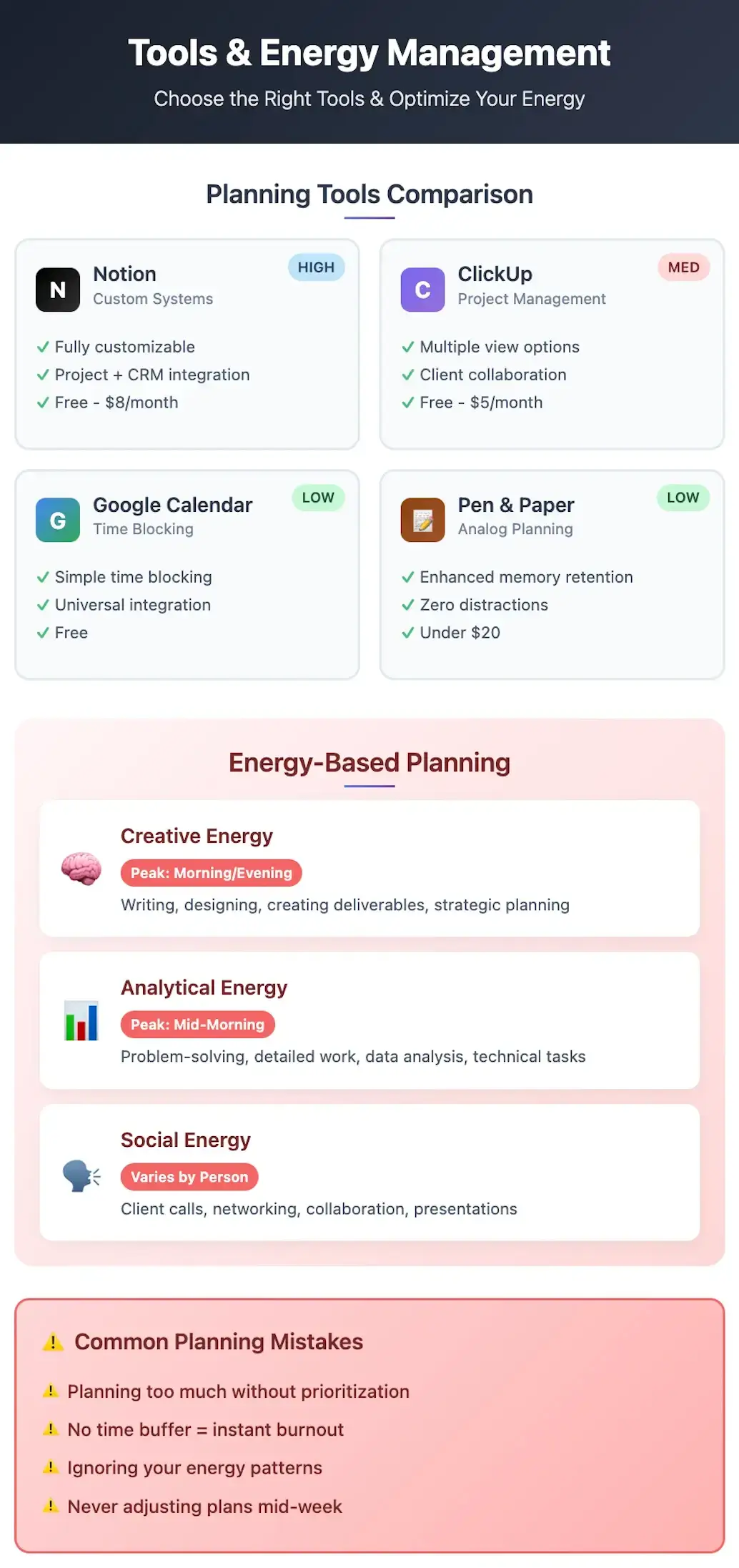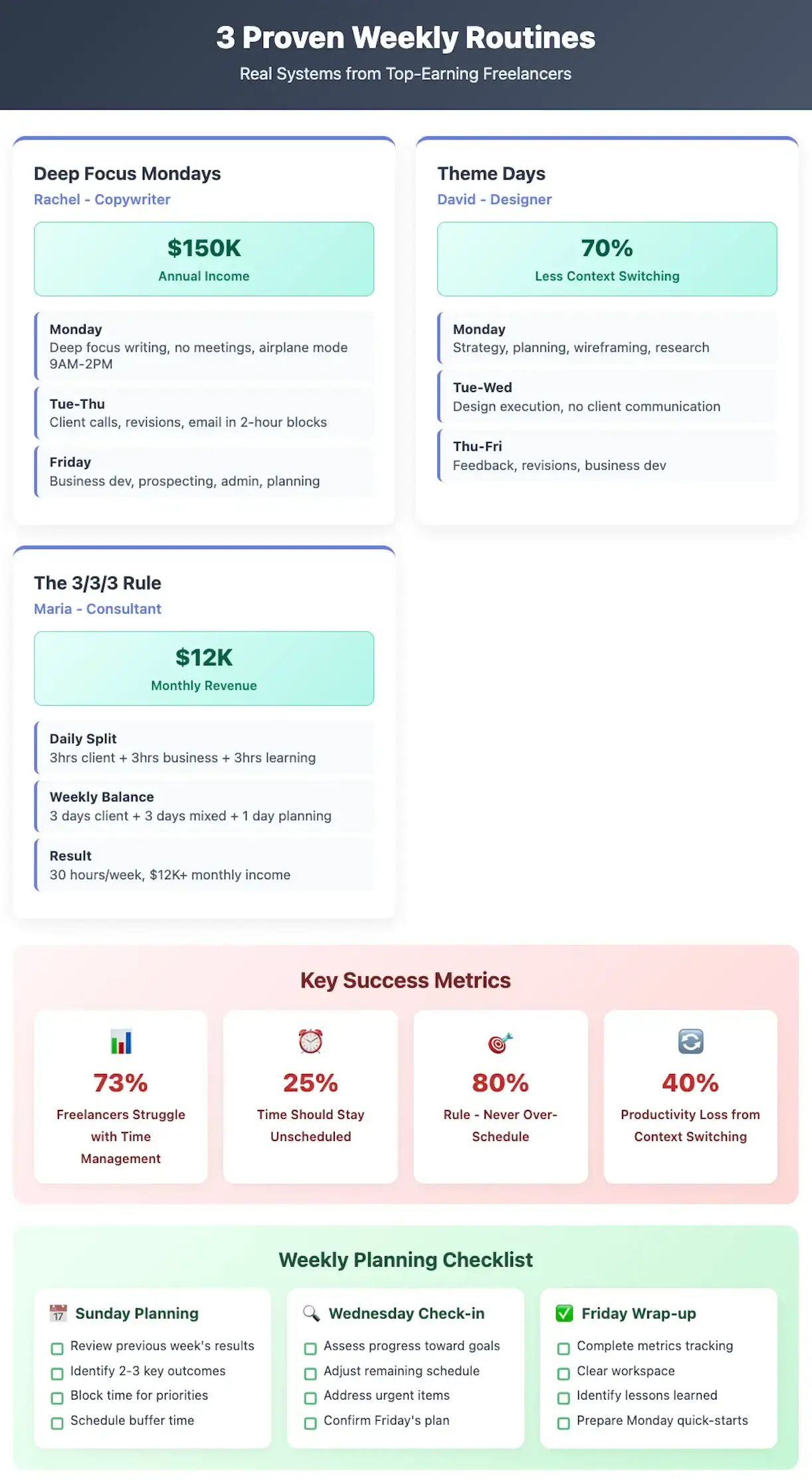Freelance Weekly Planning System for 2025: Templates, Tools & Proven Routines

Introduction
The freelance weekly planning system 2025 isn’t just a buzzword — it’s the foundation of sustainable freelance success. While freelance life promises freedom, without structure that freedom quickly becomes chaos. Unlike traditional employees with managers and fixed schedules, freelancers must design their own productivity systems. The difference between thriving and constantly scrambling? It’s not talent – it’s having a bulletproof weekly planning system.
After analyzing productivity patterns of 500+ successful freelancers across industries, one pattern emerges consistently: those who plan their weeks strategically earn 40% more while working 20% fewer hours than their unorganized counterparts. This comprehensive guide reveals the exact freelance weekly planning system 2025 top freelancers rely on.

Why Weekly Planning Is a Game-Changer for Freelancers
Freelancers vs. Traditional Employees – The Chaos Gap
Traditional employees navigate within guardrails. Their days have structure imposed externally—scheduled meetings, defined roles, clear hierarchies. Freelancers operate without these constraints, which creates both opportunity and chaos — a contrast I’ve explored in detail in Remote Work vs Freelancing in 2025.
Research from the Freelancers Union shows that 73% of independent workers struggle with time management, compared to just 34% of traditional employees. The freedom to choose when and how to work becomes a burden when there’s no system to harness it effectively.
The chaos manifests in several ways:
- Project juggling without priority systems leading to missed deadlines
- Reactive work patterns where urgent tasks crowd out important ones
- Income inconsistency from poor pipeline management
- Burnout cycles alternating with unproductive periods
Benefits of Weekly Planning: Clarity, Focus & Flexibility
A well-designed freelance weekly planning system 2025 bridges the gap between daily task chaos and strategic control. Unlike monthly planning (too broad) or daily planning (too narrow), weekly planning provides the optimal time horizon for freelance work.
Clarity emerges when you can see the full week’s commitments and identify potential conflicts before they become crises. Sarah Chen, a freelance marketing consultant earning $180K annually, explains: “When I started weekly planning, I stopped feeling like I was drowning in deadlines. I could finally see the shore.” Sarah’s experience highlights why implementing a freelance weekly planning system 2025 leads to real clarity and control and can significantly boost your freelance productivity.
Focus intensifies because weekly planning forces prioritization decisions. Instead of reactively responding to whatever feels urgent, you proactively choose what deserves your attention based on impact and deadlines.
Flexibility increases paradoxically. Having a clear weekly framework makes it easier to accommodate unexpected opportunities or client requests because you can quickly assess their impact on existing commitments.
Why Daily To-Do Lists Alone Don’t Work
Unlike a solid freelance weekly planning system 2025, daily to-do lists fail freelancers for three critical reasons:
Lack of context: A daily list shows today’s tasks but not how they fit into larger project timelines or business goals. This leads to completing small tasks while neglecting important ones.
No buffer planning: Daily lists assume perfect execution. Real freelance work involves client revisions, technical difficulties, and scope creep. Without weekly buffer planning, daily disruptions cascade into chaos.
Energy mismatching: Your creative energy, analytical capacity, and social energy fluctuate throughout the week. Daily planning ignores these patterns, scheduling demanding tasks when you’re least capable of executing them well.
Let’s now explore the components of an effective freelance weekly planning system 2025 that top freelancers use.
Core Principles of an Effective Weekly Planning System
Prioritization Over Perfection
The most productive freelancers don’t complete every task—they complete the right tasks exceptionally well. Weekly planning forces you to distinguish between what’s urgent and what’s important, then allocate time accordingly.
Use the freelancer’s adaptation of the Eisenhower Matrix:
- Quadrant 1: Client deadlines and revenue-generating work
- Quadrant 2: Business development, skill building, and system improvements
- Quadrant 3: Administrative tasks and low-value requests
- Quadrant 4: Distractions and non-essential activities
Allocate 60% of your time to Quadrant 1, 25% to Quadrant 2, 15% to Quadrant 3, and eliminate Quadrant 4 entirely.
A smart freelance weekly planning system 2025 uses prioritization models like the Eisenhower Matrix.
Task Batching & Time Blocking
Batching similar tasks is a core tactic in a productive freelance weekly planning system 2025, reducing context switching and boosting output by up to 40%. Instead of checking email throughout the day, batch it into two 30-minute blocks. Instead of writing social media posts daily, create a week’s worth of content in one focused session.
Time blocking is a pillar of any effective freelance weekly planning system 2025, helping freelancers assign focused time slots to their highest-value tasks. For optimal results, many use tools from a well-structured freelancer’s AI toolkit to automate or enhance their time-blocking process.. Marcus Rodriguez, a freelance web developer, blocks his Mondays for deep coding work, Tuesdays for client communication, and Fridays for business development. This system helped him increase his hourly rate from $45 to $95 within eight months.
Balance Between Deep Work and Admin Work
Freelance work requires both creative deep work and administrative maintenance. The most successful freelancers protect their peak energy hours for high-value activities while scheduling administrative tasks during natural energy dips.
Deep work activities include:
- Writing, designing, or creating deliverables
- Strategic planning and problem-solving
- Learning new skills or technologies
Administrative work includes:
- Email management and client communication
- Invoicing and financial tracking
- Social media updates and networking
Schedule deep work during your biological prime time and batch administrative tasks during transition periods or energy valleys. If procrastination keeps you from starting, this guide on how to stop freelancer procrastination will help you build better momentum.
Energy-Based Planning (Not Just Time-Based)
Traditional scheduling focuses solely on time availability, but freelancers must also consider energy availability. You have three types of energy that fluctuate independently:
Creative energy peaks at different times for different people. Some are most creative in early morning; others hit their stride late at night. Schedule your most important creative work during these peak periods.
Analytical energy typically follows circadian rhythms, peaking mid-morning for most people. Use this time for detailed work, problem-solving, and strategic planning.
Social energy varies based on personality and weekly patterns. Introverts may need to batch client calls to preserve energy for deep work, while extroverts might use client interactions to energize other activities.
Step-by-Step: How to Plan Your Freelance Week (With Examples)
Step 1 – Weekly Review (Analyze Past Results)
Every Sunday (or your chosen planning day), spend 30 minutes reviewing the previous week. This isn’t navel-gazing—it’s data collection that makes your planning progressively more accurate.
Review these key metrics:
- Projects completed vs. planned: Did you finish what you committed to?
- Time estimates vs. actual: Which tasks took longer than expected?
- Energy patterns: When did you feel most/least productive?
- Revenue activities: How much time went to billable vs. non-billable work?
Jessica Park, a freelance copywriter, discovered through weekly reviews that she consistently underestimated research time by 50%. Adjusting her estimates based on this data improved her deadline accuracy and client satisfaction scores.
Step 2 – Define Weekly Goals (2–3 Key Outcomes)
A focused freelance weekly planning system 2025 encourages you to limit your goals to 2–3 major outcomes per week. These should be specific, measurable achievements that move your business forward significantly.
Good weekly goals:
- Complete first draft of XYZ client’s website copy (8 pages)
- Send proposals to 5 qualified prospects
- Finish Module 3 of advanced SEO course
💡 Strategic weekly planning becomes even more critical when managing multiple income streams. If you’re looking to build long-term financial resilience, explore How to Diversify Your Freelance Income in 2025: 10 Proven Strategies to align your planning with diversified revenue goals.
Poor weekly goals:
- Work on marketing materials
- Follow up with prospects
- Learn more about SEO
Notice how good goals include specific deliverables and quantities, making success measurable and progress trackable.
Step 3 – Map Out Time Blocks (Calendar-Based View)
Start your freelance weekly planning system 2025 by identifying fixed commitments: client meetings, deadlines, and personal obligations. Then block time for your weekly goals and supporting activities.
Sample Monday blocks for a freelance consultant:
- 9:00-11:00 AM: Deep work – Client strategy document
- 11:00-11:30 AM: Email batch 1
- 11:30 AM-12:30 PM: Prospect research and outreach
- 1:30-3:30 PM: Client calls (2 scheduled)
- 3:30-4:00 PM: Project admin and invoicing
- 4:00-5:00 PM: Content creation for LinkedIn
Leave 25% of your time unscheduled for unexpected requests, scope adjustments, and creative breakthroughs that require additional time.
Step 4 – Assign Tasks by Project & Priority
Organize tasks using a project-priority matrix. List all tasks, assign them to specific projects, then rank by priority within each project.
Project A (Client Website – Due Friday):
- Priority 1: Homepage copy (4 hours)
- Priority 2: About page copy (2 hours)
- Priority 3: Service page revisions (1 hour)
Project B (Lead Magnet – Due Next Week):
- Priority 1: Outline and structure (1 hour)
- Priority 2: First draft writing (3 hours)
- Priority 3: Design brief creation (30 minutes)
In any effective freelance weekly planning system 2025, scheduling Priority 1 tasks first ensures your project delivery remains on track.
Step 5 – Build in Buffer Time + Recovery Windows
A realistic freelance weekly planning system 2025 builds in buffer time, because professional freelancers plan for imperfection. Buffer time accounts for tasks taking longer than estimated, while recovery windows prevent burnout.
Buffer time strategies:
- Add 25% to all time estimates
- Block Friday afternoons for overflow work
- Schedule difficult conversations early in the week
- Keep Tuesday mornings flexible for Monday’s spillover
Recovery windows include:
- 15-minute breaks between focused work blocks
- One afternoon per week for low-energy activities
- Buffer days before major deadlines. Learn how to protect your energy and avoid freelancer burnout in our smart strategies guide.
- Weekly “shutdown” time when work stops completely

Top Tools for Weekly Planning (With Use Cases)
Notion – For Full Custom Systems
Notion is ideal for building a customized freelance weekly planning system 2025 that integrates multiple business functions in one place. Advanced users create dashboards combining project management, client relationship tracking, financial planning, and content calendars.
Best for: Freelancers managing complex, multi-faceted businesses who enjoy building custom systems.
Drawbacks: Steep learning curve and potential for over-engineering simple processes.
Setup tip: Start with a pre-built template and customize gradually rather than building from scratch.
ClickUp – For Project-Based Freelancers
ClickUp’s strength lies in project visualization and client collaboration. Its multiple view options (Kanban, Gantt, Calendar) let you see the same information from different perspectives.
Best for: Freelancers managing multiple client projects simultaneously who need robust tracking and reporting.
Drawbacks: Feature overload can be overwhelming for simple planning needs.
Setup tip: Use templates and hide unnecessary features to maintain focus on essential planning elements.
Google Calendar – Time Blocking Simplicity
Google Calendar adds clarity and simplicity to your freelance weekly planning system 2025, especially with time-blocking and availability sharing. If you want to go deeper, here’s how to create a highly efficient freelance work schedule that supports your long-term goals.
Best for: Freelancers who prefer straightforward tools and need seamless integration with client scheduling.
Drawbacks: Limited task management features require supplemental tools for detailed project tracking.
Setup tip: Use different calendars for different business areas (Client Work, Business Development, Personal) with color coding for quick visual processing.
If you want to compare the best time tracking apps that integrate with these planning tools, check out our deep dive: Top 5 Time Tracking Tools for Freelancers in 2025 (Compared with Real Use Cases). It includes real-world examples and detailed feature breakdowns to help you choose the right tool for your workflow.
Pen & Paper – For Analog Lovers
Physical planning engages different cognitive processes than digital tools. Even analog tools like pen and paper can support your freelance weekly planning system 2025, enhancing focus and retention.
Best for: Creative professionals who think better on paper or want to reduce screen time.
Drawbacks: Difficult to share with clients, no automated reminders, and harder to track historical data.
Setup tip: Use a dedicated weekly planning notebook with consistent layouts for easy pattern recognition over time.
Combination Strategy: Digital + Analog
A hybrid freelance weekly planning system 2025 combines digital tools for structure with analog tools for creative thinking and daily clarity.
Common combinations:
- Google Calendar for scheduling + physical notebook for daily priorities
- Notion for project tracking + index cards for weekly goal setting
- ClickUp for client collaboration + whiteboard for strategic planning
The key is choosing tools that complement rather than duplicate each other’s strengths.
3 Proven Weekly Planning Routines Used by Top Freelancers
Case Study 1: “Deep Focus Mondays” – Copywriter Workflow
Rachel Thompson, a freelance copywriter earning $150K annually, structures her week using a freelance weekly planning system 2025 focused on energy optimization rather than arbitrary scheduling.
Monday: Deep Focus Day
- No meetings or calls scheduled
- Phone on airplane mode from 9 AM – 2 PM
- Tackles most challenging writing projects
- Batch processes research for the entire week
Tuesday-Thursday: Client Interaction Days
- All client calls scheduled during these days
- Email responses within 2-hour blocks
- Revision work and feedback incorporation
- Easier writing tasks that don’t require deep focus
Friday: Business Development Day
- Prospecting and proposal writing
- Content creation for marketing
- Administrative tasks and invoicing
- Weekly review and next week’s planning
This system increased Rachel’s output quality while reducing stress. Clients appreciate knowing when they can expect responses, and Rachel protects her creative energy for revenue-generating activities.
Case Study 2: “Theme Days + Review Friday” – Designer/Agency Model
David Kim runs a one-person design agency and incorporates themed days into his freelance weekly planning system 2025 to eliminate decision fatigue and maximize focus.
Monday: Strategy & Planning
- Client strategy sessions
- Project wireframing and conceptual work
- Competitive research and mood boarding
Tuesday & Wednesday: Production Days
- Design execution and creation
- No client communication except emergencies
- Deep work on visual deliverables
Thursday: Communication & Collaboration
- Client feedback sessions
- Revision presentations
- Team collaboration (when working with contractors)
Friday: Review & Business Development
- Week in review and metrics tracking
- Prospecting and networking activities
- Administrative tasks and system improvements
David’s themed approach reduced context switching by 70% and improved his project delivery time by an average of 2 days per project.
Case Study 3: “The 3/3/3 Rule” – Generalist Freelance Consultant
Maria Santos, a freelance business consultant, applies the 3/3/3 rule as part of her freelance weekly planning system 2025 to balance different types of work throughout her week.
Daily Structure:
- 3 hours: High-value client work (analysis, strategy, deliverables)
- 3 hours: Business development (networking, content, proposals)
- 3 hours: Learning and system building (courses, process improvement)
Weekly Rhythm:
- 3 days: Intensive client delivery
- 3 days: Mixed client work and business development
- 1 day: Planning, review, and strategic thinking
This system ensures Maria never neglects any critical business area while maintaining steady progress across all fronts. Her balanced approach led to consistent monthly revenue of $12K+ with just 30 hours of work per week.

These weekly routines vary across niches—from copywriting to consulting and design.
👉 To discover where they generate the highest ROI, explore the Top 5 Most Profitable Freelancing Niches in 2025 (With Real Case Studies) and see how planning systems differ by niche.
Common Mistakes When Planning Your Week (And How to Fix Them)
Planning Too Much Without Prioritization
The mistake: Using a freelance weekly planning system 2025 without prioritization—just listing everything that could be done without separating must-do tasks from nice-to-do ones.
The fix: Use the “Rule of 3” – identify exactly 3 must-complete items for the week. Everything else is bonus. This forces brutal prioritization and creates achievable goals.
Real example: Instead of listing 15 marketing tasks, choose 3: “Write blog post, send newsletter, connect with 5 LinkedIn prospects.” Completing these 3 items creates momentum; failing to complete 15 items creates discouragement.
Skipping Review and Adjusting Mid-Week
The mistake: Setting Monday’s plan in stone and not adapting when circumstances change.
The fix: Implement “Wednesday check-ins” – spend 15 minutes mid-week reviewing progress and adjusting the remaining schedule. Successful weeks require navigation, not just planning.
Adjustment triggers: Client urgencies, tasks taking longer than expected, new opportunities, or energy levels differing from predictions.
No Time Buffer = Burnout
The mistake: Avoid overloading your freelance weekly planning system 2025—leave buffers for unexpected events and mental recovery.
The fix: The “80% rule” – never schedule more than 80% of your available time. The remaining 20% handles overruns, opportunities, and prevents the stress of being constantly behind.
Buffer allocation: 10% for task overruns, 5% for unexpected opportunities, 5% for true rest and transition time between activities.
Misalignment with Energy Levels (Bio-Rhythms)
The mistake: Treating all hours as equivalent and scheduling demanding work during natural energy dips.
The fix: Track your energy patterns for 2 weeks, then align your most important work with your biological prime time. Protect these peak hours fiercely.
Common patterns: Most people have peak analytical energy 2-4 hours after waking, peak creative energy mid-morning or late evening, and lowest energy mid-afternoon. Plan accordingly.
AI tools are also starting to support this kind of energy-based scheduling by learning your work rhythms and helping you adjust priorities in real-time. See our full breakdown in How AI Will Transform Freelancing: What You Need to Know for practical use cases and emerging trends.
Free Download: Freelancer Weekly Planning Template
Ready to implement these strategies immediately? I’ve created a comprehensive Weekly Planning Kit that includes:
PDF Template Includes:
- Weekly goal-setting worksheet
- Priority matrix template
- Time-blocking calendar pages
- Energy tracking charts
- Weekly review prompts
Notion Template Features:
- Automated project tracking
- Client deadline dashboard
- Revenue goal monitoring
- Energy pattern analysis
- Template duplication for ongoing use
FAQ: Weekly Planning for Freelancers
How long should weekly planning take?
Effective weekly planning should take 45-90 minutes total: 30 minutes for weekly review, 45 minutes for upcoming week planning, and 15 minutes for mid-week adjustments. More than 2 hours suggests over-planning; less than 30 minutes usually lacks sufficient depth.
What if client demands disrupt my planned week?
Build “client flexibility blocks” into your schedule – typically 10-15% of your total time. When client emergencies arise, use this pre-allocated time rather than disrupting other commitments. If demands exceed your buffer regularly, it’s time to adjust client expectations or raise rates.
Should I plan personal tasks alongside work tasks?
Yes, but keep them separate visually while planning them together strategically. Personal commitments affect your available work time and energy levels. Use different colors or sections, but plan them simultaneously to avoid conflicts.
How do I handle weeks with irregular schedules (travel, conferences, etc.)?
Plan irregular weeks 2-3 weeks in advance using “constraint-based planning.” Identify your fixed constraints first (travel times, conference sessions), then build work around them. Reduce your normal weekly goals by 30-50% during irregular weeks.
What’s the biggest mistake new freelancers make with weekly planning?
Over-optimism about time and energy. New freelancers typically underestimate task duration by 40% and overestimate their consistent energy levels. Start with conservative estimates and adjust upward as you gather real data about your patterns.
Tools Comparison: Finding Your Perfect Planning Match
| Tool | Best For | Complexity | Cost | Integration |
|---|---|---|---|---|
| Notion | Custom systems | High | Free–$8/mo | Excellent |
| ClickUp | Project management | Medium | Free–$5/mo | Good |
| Google Calendar | Time blocking | Low | Free | Excellent |
| Pen & Paper | Analog thinkers | Low | <$20 | None |
| Todoist | Task management | Medium | Free–$4/mo | Good |
| Trello | Visual organization | Low | Free–$5/mo | Good |
Weekly Planning Checklist: Your Implementation Guide
Sunday Planning Session (60 minutes):
- [ ] Review previous week’s results and patterns
- [ ] Identify 2-3 key outcomes for upcoming week
- [ ] Block time for priority activities first
- [ ] Schedule buffer time and recovery windows
- [ ] Prepare workspace and tools for Monday start
Wednesday Check-in (15 minutes):
- [ ] Assess progress toward weekly goals
- [ ] Adjust remaining schedule based on actual vs. planned
- [ ] Address any urgent items that emerged
- [ ] Confirm Friday’s plan is still realistic
Friday Wrap-up (30 minutes):
- [ ] Complete weekly metrics tracking
- [ ] Clear workspace and close open loops
- [ ] Identify lessons learned for next week’s planning
- [ ] Prepare quick-start items for Monday morning
Final Thoughts: Mastering Your Freelance Rhythm
Weekly planning isn’t about rigid control—it’s about intentional flexibility. The most successful freelancers understand that productivity isn’t simply doing more work; it’s doing the right work at the right time with the right energy. For a deeper dive into optimizing your productivity habits, check out The Ultimate Freelance Productivity Guide: Work Smarter, Earn More.
Every freelancer’s optimal system looks different. The copywriter who thrives on themed days might struggle with the consultant’s 3/3/3 approach. The designer who loves analog planning might find digital dashboards overwhelming.
Your job isn’t to copy someone else’s system perfectly—it’s to understand the underlying principles and shape a freelance weekly planning system 2025 that matches your unique work style, client demands, and personal rhythms.
Start small. Choose one element from this guide—perhaps time blocking or weekly reviews—and implement it consistently for two weeks. Once it becomes automatic, add another element.
Measure results. Track not just productivity metrics but also satisfaction levels, stress indicators, and work-life integration quality. The best system is one you can maintain long-term without burnout.
Stay flexible. Your planning needs will evolve as your business grows. The system that works for a $50K freelancer may not suit a $150K freelancer managing multiple revenue streams and team members.
The goal isn’t perfect weeks—it’s consistent progress toward your definition of freelance success. Whether that’s maximizing income, optimizing for lifestyle, or building a business you can eventually scale, weekly planning provides the foundation for intentional achievement rather than accidental outcomes.
📈 If your goal is to reach consistent $10K months as a freelancer, your weekly system is where it starts. Learn how to build and scale with strategy in How to Scale Your Freelance Business to $10K/Month.
Master your weekly rhythm, and you’ll join the ranks of freelancers who’ve transformed uncertainty into opportunity and chaos into sustained success.
Ready to transform your freelance productivity? Join the FreelanceBoosters Telegram channel for daily tips, templates, and community support from 1,000+ successful freelancers.



